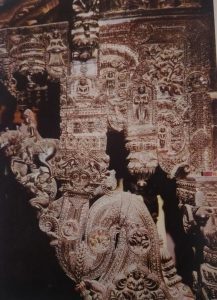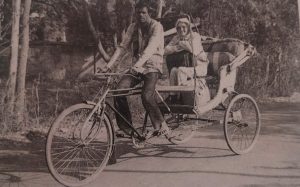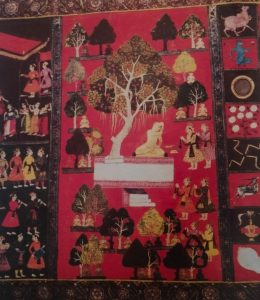Karanja
 Karanja: Balatkara Gana Mandir. A sample of the superb wood-carvings to be marvelled at in this seldom mentioned temple. Its other treasures — icons in both stone and metal – are of an equally high standard.
Karanja: Balatkara Gana Mandir. A sample of the superb wood-carvings to be marvelled at in this seldom mentioned temple. Its other treasures — icons in both stone and metal – are of an equally high standard.
Karanja, a town of around $1,000 inhabitants of which c.4500 are Jainas, is another place in Maharashtra State that leaves the visitor astounded at what he finds there in his pursuit of sacred art.
The Jainas of Karanja are descendants of Rajasthani families who left their home region of Kota and Bundi during Mughal times and eventually reached Karanja, some seven hundred kilometres south. The reason for their migration or flight is not known, yet, once settled in their new environment, they succeeded in establishing solid means of livelihood, in retaining their religion and in building temples.
They also took to supporting the arts. Interestingly, experts on Jaina pictorial art had to amend some of their conclusions when a painting on cloth over twelve metres in length and about eighty centimetres in width was discovered in the Sena Gana Mandir at Karanja, for this find threw new light on how Jaina pictorial art expanded itself.
The painting is composed, as the name pancha-kalyanaka pata indicates, of a series of pictures (pata) which depict the five (pancha) benedictory events (kalyanaka) in the life of every new Tirthankara. In the present case it is Rishabha or Adinatha, the first of the last twenty-four. Unfortunately there is as yet no way of permanently exhibiting this rare piece of art within the Sena Gana Mandir, but sooner or later a generous patron of fine Jaina art should come forward and finance the building of an appropriately glazed encasement.
Whereas this painting – it may well be the longest of its kind in India – is for obvious reasons not freely accessible, the other art treasures in Karanja’s three Jaina temples are there to be viewed and admired during the usual opening hours any day of the year. Of great attraction are the elaborately carved wooden pillars and archi- traves in the Balatkara Gana Mandir and a collection of miniature Jinas made of precious stones and metals in the same temple.
Another achievement of Karanja’s Jaina community deserves the visitor’s attention. It is the local Gurukula (residential school under the guidance of a spiritual teacher) located within  a garden on the outskirts of the town. Founded in 1918, it is said to be the oldest of its kind as far as the Digambara sect is con- cemed.
a garden on the outskirts of the town. Founded in 1918, it is said to be the oldest of its kind as far as the Digambara sect is con- cemed.
At Karanja, as at other places, it hap pened to be a helpful rickshaw-driver who, one early morning after a night-long bus- ride from Indore, took us to the temples and the gurukula, the whereabouts of which we had no idea.
Detail from the twelve metre long painting on cloth kept in Karanja’s Sena Gana Mandir. The scene symbolizes the third auspicious event in the life of Adinatha: his decision to renounce worldly life and become a mendicant.
The scene symbolizes the third auspicious event in the life of Adinatha: his decision to renounce worldly life and become a mendicant.
It depicts the abdicated emperor seated under a tree and pulling out his hair. To his left and right, members of the retinue who acclaimingly followed him on his way from the palace. The vertical panel on the right shows eight of the twenty-four emblems assigned to the Tirthankaras 